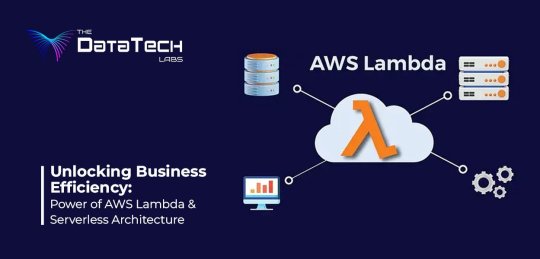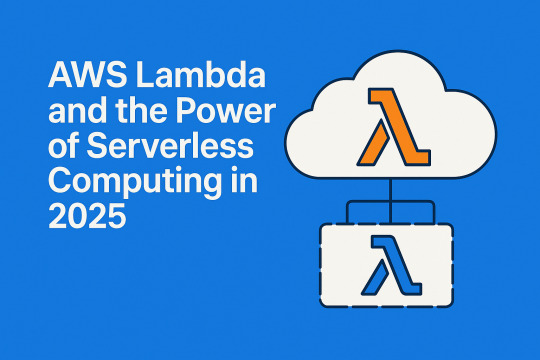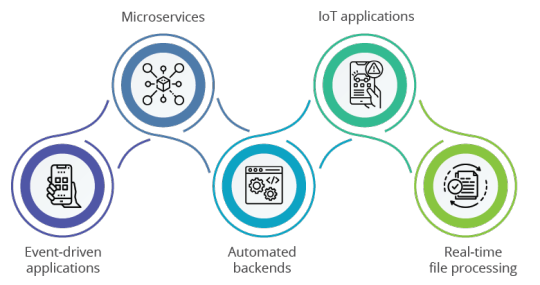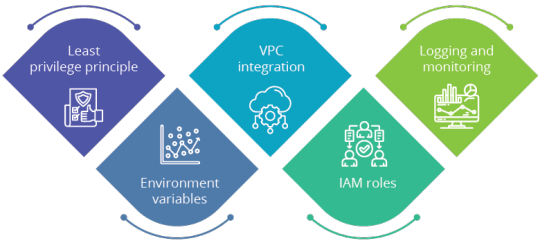#AWS Lambda Serverless
Explore tagged Tumblr posts
Text
#Serverless architecture beyond AWS Lambda#Event-driven systems and edge computing#Backend-as-a-Service (BaaS) in modern applications#Spotify
0 notes
Text
Serverless Computing: Streamlining Web Application Deployment
0 notes
Text
#Build#serverless#apps#node.js#awscloud#aws lambda#trends 2024#applications#development#application development#architecture#follow#machine learning#programming#coding#future trends#architettura
1 note
·
View note
Text
The Serverless Development Dilemma: Local Testing in a Cloud-Native World
Picture this: You’re an AWS developer, sitting in your favorite coffee shop, sipping on your third espresso of the day. You’re working on a cutting-edge serverless application that’s going to revolutionize… well, something. But as you try to test your latest feature, you realize you’re caught in a classic “cloud” vs “localhost” conundrum. Welcome to the serverless development dilemma! The…
#AWS DevOps#AWS Lambda#CI/CD#Cloud Native#Developer Productivity#GitLab CI#Microservices#serverless#Terraform State
0 notes
Text
Serverless Deployment using AWS Lambda and API Gateway
Serverless architecture offers a compelling solution with its pay-per-use model and automatic scaling. This blog post will explore building a scalable serverless architecture using AWS Lambda and API Gateway.
IntroductionUnderstanding Serverless ArchitectureCore Components: AWS Lambda and API GatewayBuilding a Scalable Serverless ArchitectureExample Architecture: Processing API Requests and Saving DataBenefits of Serverless ArchitectureConclusionRelated Posts Introduction In today’s fast-paced digital world, applications must handle fluctuating workloads without compromising performance or cost.…
0 notes
Text
Explore the best practices for using AWS Lambda, including where to use it, security implications, performance optimization, and cost management tips. Learn how to leverage serverless computing effectively for scalable and secure applications.
0 notes
Text
Unlocking Business Efficiency Power of AWS Lambda and Serverless Architecture
Unlock the power of AWS Lambda and embrace Serverless Architecture to revolutionize your business. Discover unparalleled scalability, reduced costs, and heightened innovation. Learn from real-world success stories and propel your operations into the future with agility and efficiency.

#AWS Lambda#Serverless Architecture#Business Efficiency#Innovation#Scalability#Digital Transformation#Learning Transformation#Business Transformation#TheDatatechLabs
0 notes
Text
Serverless computing is not a new concept, but when you combine it with AWS Lambda and API Gateway, it becomes a game-changer. This powerful trio empowers developers to create and deploy applications without the hassle of server management.
Explore the world of serverless, where innovation, scalability, and simplified management take center stage. Also, you can experience the future of software development with serverless and unlock the full potential of your project.
1 note
·
View note
Text
AWS Lambda and the Power of Serverless Computing in 2025

In a time when speed, scalability, and efficiency are critical to software development, serverless computing has emerged as a transformative approach to building cloud-native applications. At the forefront of this shift is AWS Lambda, Amazon Web Services' flagship serverless compute service that allows developers to run code without managing servers.
By offloading infrastructure concerns to AWS, Lambda enables teams to focus purely on code, reducing operational overhead while improving flexibility and performance. But what exactly makes this service so powerful? Let’s explore how AWS Expert Lambda is shaping modern cloud architecture in 2025.
What is AWS Lambda?
AWS Lambda is a serverless computing service that executes code in response to events. You simply write your code in supported languages, upload it to Lambda, and AWS handles the provisioning, scaling, and maintenance of the underlying servers. Whether it's a file upload to Amazon S3, a change in a DynamoDB table, or an API call, Lambda automatically runs your function in a highly available and fault-tolerant environment.
No Server Management Required
One of Lambda’s biggest advantages is that you don’t need to manage servers at all. AWS handles the entire infrastructure layer—including provisioning, scaling, security patches, and operating system updates. This serverless model reduces operational burden and accelerates your development lifecycle, enabling teams to ship features faster.
Event-Driven by Design
AWS Lambda operates on an event-driven architecture, executing functions in response to specific triggers. These events can originate from multiple AWS services or external applications. For example, uploading an image to S3 can trigger Lambda to generate a thumbnail, or a new record in a database can launch a data processing workflow.
This design pattern is ideal for building reactive and automated systems, particularly for microservices, IoT applications, and real-time data processing.
Automatic and Instant Scaling
Scaling applications can be challenging and expensive in traditional environments. Lambda removes this complexity with built-in auto-scaling. Your code can handle a single request or thousands per second—Lambda dynamically allocates resources based on traffic volume. This responsiveness makes it ideal for unpredictable or spiky workloads without requiring any configuration changes from your end.
Stateless Function Execution
Lambda functions are stateless, which means each invocation runs in isolation without relying on persistent memory or session data from previous runs. This independence boosts scalability and reliability. If your application requires persistent data, it can integrate with services like Amazon RDS, DynamoDB, or S3 for external storage.
Cost-Efficiency with Pay-Per-Use Billing
With AWS Lambda, you only pay for what you actually use. Billing is based on the number of requests and the duration your code runs, measured in milliseconds. There are no charges for idle resources, which is particularly useful for workloads that experience infrequent or inconsistent traffic.
This model provides significant cost savings compared to traditional server-based deployments, especially for startups and small businesses managing limited budgets.
Deep Integration with the AWS Ecosystem
Lambda functions integrate effortlessly with a broad range of AWS services such as:
Amazon API Gateway for creating RESTful APIs
Amazon S3 for object storage
Amazon DynamoDB for NoSQL data storage
Amazon Kinesis for real-time streaming data
Amazon CloudWatch for monitoring and logging
This integration capability enables developers to construct powerful, event-driven applications without building glue code or custom infrastructure.
Multi-Language Support
AWS Lambda supports several mainstream programming languages including:
Python
Node.js
Java
Ruby
C#
PowerShell
In addition, AWS allows developers to create custom runtimes, giving even more freedom to use niche or in-house languages. This makes Lambda suitable for a wide range of development teams and use cases.
Real-World Applications of Lambda
AWS Lambda is already widely used in diverse scenarios:
Web application backends: Handle requests and responses efficiently without provisioning servers.
Image and file processing: Automatically resize or analyze media files as they’re uploaded.
ETL pipelines: Transform and load data in real-time from one service to another.
IoT automation: Trigger events based on sensor input or device behavior.
Chatbots and voice assistants: Manage conversational logic in platforms like Amazon Alexa.
Challenges and Considerations
While Lambda offers many advantages, it’s important to understand potential limitations:
Cold starts: There can be a slight delay when functions are invoked after a period of inactivity.
Execution time limits: Each Lambda function has a maximum execution duration (currently 15 minutes).
Monitoring complexity: Observability across distributed Lambda functions can be more challenging than monolithic apps, but services like AWS CloudWatch and X-Ray help bridge that gap.
Conclusion
AWS Lambda is not just a cost-effective solution; it’s a catalyst for innovation. By abstracting infrastructure management, it empowers developers to focus on delivering business value. From startups building MVPs to enterprises scaling microservices, Lambda has become an essential part of the modern cloud toolkit.
If you're seeking to future-proof your applications while reducing infrastructure overhead, AWS Lambda is a platform worth adopting. Start small, experiment with real-world triggers, and let AWS handle the complexity behind the scenes.
0 notes
Text





Dive into the World of AWS Lambda! 🚀 Discover the power of serverless computing and how AWS Lambda is reshaping the future of cloud services.
Let's explore the innovative world of serverless functions! 💡☁️
#aws#aws cloud services#aws lambda#power#serverless com#future#cloud services#innovation#serverless function
1 note
·
View note
Video
youtube
Serverless Architecture & Deployment Design Pattern for Microservices wi... Full Video Link https://youtu.be/b9Gpt4OOlgoHello friends, new #video on #serverless #deployment #designpattern for #microservices #tutorial for #developer #programmers with #examples are published on #codeonedigest #youtube channel. @java #java #aws #awscloud @awscloud @AWSCloudIndia #salesforce #Cloud #CloudComputing @YouTube #youtube #azure #msazure #codeonedigest @codeonedigest #microservices #microservices #cloud #serverless #whataremicroservices #microservicestutorial #microservicesarchitecture #serverlessmicroservices #serverlessframeworksetup #serverlessdeployment #serverlessdeploymentaws #serverlessdeploymentbucket #serverlessdeploymentazure #serverlessdeploymentplatform #serverlessdeployfunction #serverlessdesignpattern #serverlessarchitecture #serverlesscomputing #serverlessmicroservicesexplained #serverlessmicroservicesexample #design
#youtube#serverless#serverless deployment#aws lambda#aws fargate#azure function#google cloud function#serverless infrastructure
1 note
·
View note
Text
#AntStack TV Episode 6#Serverless Security Best Practices#Secure Serverless Applications#Serverless Architecture#IAM Policies for Serverless#Serverless Security for Developers#AWS Lambda Security#Spotify
0 notes
Text
How Python Powers Scalable and Cost-Effective Cloud Solutions

Explore the role of Python in developing scalable and cost-effective cloud solutions. This guide covers Python's advantages in cloud computing, addresses potential challenges, and highlights real-world applications, providing insights into leveraging Python for efficient cloud development.
Introduction
In today's rapidly evolving digital landscape, businesses are increasingly leveraging cloud computing to enhance scalability, optimize costs, and drive innovation. Among the myriad of programming languages available, Python has emerged as a preferred choice for developing robust cloud solutions. Its simplicity, versatility, and extensive library support make it an ideal candidate for cloud-based applications.
In this comprehensive guide, we will delve into how Python empowers scalable and cost-effective cloud solutions, explore its advantages, address potential challenges, and highlight real-world applications.
Why Python is the Preferred Choice for Cloud Computing?
Python's popularity in cloud computing is driven by several factors, making it the preferred language for developing and managing cloud solutions. Here are some key reasons why Python stands out:
Simplicity and Readability: Python's clean and straightforward syntax allows developers to write and maintain code efficiently, reducing development time and costs.
Extensive Library Support: Python offers a rich set of libraries and frameworks like Django, Flask, and FastAPI for building cloud applications.
Seamless Integration with Cloud Services: Python is well-supported across major cloud platforms like AWS, Azure, and Google Cloud.
Automation and DevOps Friendly: Python supports infrastructure automation with tools like Ansible, Terraform, and Boto3.
Strong Community and Enterprise Adoption: Python has a massive global community that continuously improves and innovates cloud-related solutions.
How Python Enables Scalable Cloud Solutions?
Scalability is a critical factor in cloud computing, and Python provides multiple ways to achieve it:
1. Automation of Cloud Infrastructure
Python's compatibility with cloud service provider SDKs, such as AWS Boto3, Azure SDK for Python, and Google Cloud Client Library, enables developers to automate the provisioning and management of cloud resources efficiently.
2. Containerization and Orchestration
Python integrates seamlessly with Docker and Kubernetes, enabling businesses to deploy scalable containerized applications efficiently.
3. Cloud-Native Development
Frameworks like Flask, Django, and FastAPI support microservices architecture, allowing businesses to develop lightweight, scalable cloud applications.
4. Serverless Computing
Python's support for serverless platforms, including AWS Lambda, Azure Functions, and Google Cloud Functions, allows developers to build applications that automatically scale in response to demand, optimizing resource utilization and cost.
5. AI and Big Data Scalability
Python’s dominance in AI and data science makes it an ideal choice for cloud-based AI/ML services like AWS SageMaker, Google AI, and Azure Machine Learning.
Looking for expert Python developers to build scalable cloud solutions? Hire Python Developers now!
Advantages of Using Python for Cloud Computing
Cost Efficiency: Python’s compatibility with serverless computing and auto-scaling strategies minimizes cloud costs.
Faster Development: Python’s simplicity accelerates cloud application development, reducing time-to-market.
Cross-Platform Compatibility: Python runs seamlessly across different cloud platforms.
Security and Reliability: Python-based security tools help in encryption, authentication, and cloud monitoring.
Strong Community Support: Python developers worldwide contribute to continuous improvements, making it future-proof.
Challenges and Considerations
While Python offers many benefits, there are some challenges to consider:
Performance Limitations: Python is an interpreted language, which may not be as fast as compiled languages like Java or C++.
Memory Consumption: Python applications might require optimization to handle large-scale cloud workloads efficiently.
Learning Curve for Beginners: Though Python is simple, mastering cloud-specific frameworks requires time and expertise.
Python Libraries and Tools for Cloud Computing
Python’s ecosystem includes powerful libraries and tools tailored for cloud computing, such as:
Boto3: AWS SDK for Python, used for cloud automation.
Google Cloud Client Library: Helps interact with Google Cloud services.
Azure SDK for Python: Enables seamless integration with Microsoft Azure.
Apache Libcloud: Provides a unified interface for multiple cloud providers.
PyCaret: Simplifies machine learning deployment in cloud environments.
Real-World Applications of Python in Cloud Computing
1. Netflix - Scalable Streaming with Python
Netflix extensively uses Python for automation, data analysis, and managing cloud infrastructure, enabling seamless content delivery to millions of users.
2. Spotify - Cloud-Based Music Streaming
Spotify leverages Python for big data processing, recommendation algorithms, and cloud automation, ensuring high availability and scalability.
3. Reddit - Handling Massive Traffic
Reddit uses Python and AWS cloud solutions to manage heavy traffic while optimizing server costs efficiently.
Future of Python in Cloud Computing
The future of Python in cloud computing looks promising with emerging trends such as:
AI-Driven Cloud Automation: Python-powered AI and machine learning will drive intelligent cloud automation.
Edge Computing: Python will play a crucial role in processing data at the edge for IoT and real-time applications.
Hybrid and Multi-Cloud Strategies: Python’s flexibility will enable seamless integration across multiple cloud platforms.
Increased Adoption of Serverless Computing: More enterprises will adopt Python for cost-effective serverless applications.
Conclusion
Python's simplicity, versatility, and robust ecosystem make it a powerful tool for developing scalable and cost-effective cloud solutions. By leveraging Python's capabilities, businesses can enhance their cloud applications' performance, flexibility, and efficiency.
Ready to harness the power of Python for your cloud solutions? Explore our Python Development Services to discover how we can assist you in building scalable and efficient cloud applications.
FAQs
1. Why is Python used in cloud computing?
Python is widely used in cloud computing due to its simplicity, extensive libraries, and seamless integration with cloud platforms like AWS, Google Cloud, and Azure.
2. Is Python good for serverless computing?
Yes! Python works efficiently in serverless environments like AWS Lambda, Azure Functions, and Google Cloud Functions, making it an ideal choice for cost-effective, auto-scaling applications.
3. Which companies use Python for cloud solutions?
Major companies like Netflix, Spotify, Dropbox, and Reddit use Python for cloud automation, AI, and scalable infrastructure management.
4. How does Python help with cloud security?
Python offers robust security libraries like PyCryptodome and OpenSSL, enabling encryption, authentication, and cloud monitoring for secure cloud applications.
5. Can Python handle big data in the cloud?
Yes! Python supports big data processing with tools like Apache Spark, Pandas, and NumPy, making it suitable for data-driven cloud applications.
#Python development company#Python in Cloud Computing#Hire Python Developers#Python for Multi-Cloud Environments
2 notes
·
View notes
Text
The Future of Web Development: Trends, Techniques, and Tools
Web development is a dynamic field that is continually evolving to meet the demands of an increasingly digital world. With businesses relying more on online presence and user experience becoming a priority, web developers must stay abreast of the latest trends, technologies, and best practices. In this blog, we’ll delve into the current landscape of web development, explore emerging trends and tools, and discuss best practices to ensure successful web projects.
Understanding Web Development
Web development involves the creation and maintenance of websites and web applications. It encompasses a variety of tasks, including front-end development (what users see and interact with) and back-end development (the server-side that powers the application). A successful web project requires a blend of design, programming, and usability skills, with a focus on delivering a seamless user experience.
Key Trends in Web Development
Progressive Web Apps (PWAs): PWAs are web applications that provide a native app-like experience within the browser. They offer benefits like offline access, push notifications, and fast loading times. By leveraging modern web capabilities, PWAs enhance user engagement and can lead to higher conversion rates.
Single Page Applications (SPAs): SPAs load a single HTML page and dynamically update content as users interact with the app. This approach reduces page load times and provides a smoother experience. Frameworks like React, Angular, and Vue.js have made developing SPAs easier, allowing developers to create responsive and efficient applications.
Responsive Web Design: With the increasing use of mobile devices, responsive design has become essential. Websites must adapt to various screen sizes and orientations to ensure a consistent user experience. CSS frameworks like Bootstrap and Foundation help developers create fluid, responsive layouts quickly.
Voice Search Optimization: As voice-activated devices like Amazon Alexa and Google Home gain popularity, optimizing websites for voice search is crucial. This involves focusing on natural language processing and long-tail keywords, as users tend to speak in full sentences rather than typing short phrases.
Artificial Intelligence (AI) and Machine Learning: AI is transforming web development by enabling personalized user experiences and smarter applications. Chatbots, for instance, can provide instant customer support, while AI-driven analytics tools help developers understand user behavior and optimize websites accordingly.
Emerging Technologies in Web Development
JAMstack Architecture: JAMstack (JavaScript, APIs, Markup) is a modern web development architecture that decouples the front end from the back end. This approach enhances performance, security, and scalability by serving static content and fetching dynamic content through APIs.
WebAssembly (Wasm): WebAssembly allows developers to run high-performance code on the web. It opens the door for languages like C, C++, and Rust to be used for web applications, enabling complex computations and graphics rendering that were previously difficult to achieve in a browser.
Serverless Computing: Serverless architecture allows developers to build and run applications without managing server infrastructure. Platforms like AWS Lambda and Azure Functions enable developers to focus on writing code while the cloud provider handles scaling and maintenance, resulting in more efficient workflows.
Static Site Generators (SSGs): SSGs like Gatsby and Next.js allow developers to build fast and secure static websites. By pre-rendering pages at build time, SSGs improve performance and enhance SEO, making them ideal for blogs, portfolios, and documentation sites.
API-First Development: This approach prioritizes building APIs before developing the front end. API-first development ensures that various components of an application can communicate effectively and allows for easier integration with third-party services.
Best Practices for Successful Web Development
Focus on User Experience (UX): Prioritizing user experience is essential for any web project. Conduct user research to understand your audience's needs, create wireframes, and test prototypes to ensure your design is intuitive and engaging.
Emphasize Accessibility: Making your website accessible to all users, including those with disabilities, is a fundamental aspect of web development. Adhere to the Web Content Accessibility Guidelines (WCAG) by using semantic HTML, providing alt text for images, and ensuring keyboard navigation is possible.
Optimize Performance: Website performance significantly impacts user satisfaction and SEO. Optimize images, minify CSS and JavaScript, and leverage browser caching to ensure fast loading times. Tools like Google PageSpeed Insights can help identify areas for improvement.
Implement Security Best Practices: Security is paramount in web development. Use HTTPS to encrypt data, implement secure authentication methods, and validate user input to protect against vulnerabilities. Regularly update dependencies to guard against known exploits.
Stay Current with Technology: The web development landscape is constantly changing. Stay informed about the latest trends, tools, and technologies by participating in online courses, attending webinars, and engaging with the developer community. Continuous learning is crucial to maintaining relevance in this field.
Essential Tools for Web Development
Version Control Systems: Git is an essential tool for managing code changes and collaboration among developers. Platforms like GitHub and GitLab facilitate version control and provide features for issue tracking and code reviews.
Development Frameworks: Frameworks like React, Angular, and Vue.js streamline the development process by providing pre-built components and structures. For back-end development, frameworks like Express.js and Django can speed up the creation of server-side applications.
Content Management Systems (CMS): CMS platforms like WordPress, Joomla, and Drupal enable developers to create and manage websites easily. They offer flexibility and scalability, making it simple to update content without requiring extensive coding knowledge.
Design Tools: Tools like Figma, Sketch, and Adobe XD help designers create user interfaces and prototypes. These tools facilitate collaboration between designers and developers, ensuring that the final product aligns with the initial vision.
Analytics and Monitoring Tools: Google Analytics, Hotjar, and other analytics tools provide insights into user behavior, allowing developers to assess the effectiveness of their websites. Monitoring tools can alert developers to issues such as downtime or performance degradation.
Conclusion
Web development is a rapidly evolving field that requires a blend of creativity, technical skills, and a user-centric approach. By understanding the latest trends and technologies, adhering to best practices, and leveraging essential tools, developers can create engaging and effective web experiences. As we look to the future, those who embrace innovation and prioritize user experience will be best positioned for success in the competitive world of web development. Whether you are a seasoned developer or just starting, staying informed and adaptable is key to thriving in this dynamic landscape.
more about details :- https://fabvancesolutions.com/
#fabvancesolutions#digitalagency#digitalmarketingservices#graphic design#startup#ecommerce#branding#marketing#digitalstrategy#googleimagesmarketing
2 notes
·
View notes
Text
How can you optimize the performance of machine learning models in the cloud?
Optimizing machine learning models in the cloud involves several strategies to enhance performance and efficiency. Here’s a detailed approach:

Choose the Right Cloud Services:
Managed ML Services:
Use managed services like AWS SageMaker, Google AI Platform, or Azure Machine Learning, which offer built-in tools for training, tuning, and deploying models.
Auto-scaling:
Enable auto-scaling features to adjust resources based on demand, which helps manage costs and performance.
Optimize Data Handling:
Data Storage:
Use scalable cloud storage solutions like Amazon S3, Google Cloud Storage, or Azure Blob Storage for storing large datasets efficiently.
Data Pipeline:
Implement efficient data pipelines with tools like Apache Kafka or AWS Glue to manage and process large volumes of data.
Select Appropriate Computational Resources:
Instance Types:
Choose the right instance types based on your model’s requirements. For example, use GPU or TPU instances for deep learning tasks to accelerate training.
Spot Instances:
Utilize spot instances or preemptible VMs to reduce costs for non-time-sensitive tasks.
Optimize Model Training:
Hyperparameter Tuning:
Use cloud-based hyperparameter tuning services to automate the search for optimal model parameters. Services like Google Cloud AI Platform’s HyperTune or AWS SageMaker’s Automatic Model Tuning can help.
Distributed Training:
Distribute model training across multiple instances or nodes to speed up the process. Frameworks like TensorFlow and PyTorch support distributed training and can take advantage of cloud resources.
Monitoring and Logging:
Monitoring Tools:
Implement monitoring tools to track performance metrics and resource usage. AWS CloudWatch, Google Cloud Monitoring, and Azure Monitor offer real-time insights.
Logging:
Maintain detailed logs for debugging and performance analysis, using tools like AWS CloudTrail or Google Cloud Logging.
Model Deployment:
Serverless Deployment:
Use serverless options to simplify scaling and reduce infrastructure management. Services like AWS Lambda or Google Cloud Functions can handle inference tasks without managing servers.
Model Optimization:
Optimize models by compressing them or using model distillation techniques to reduce inference time and improve latency.
Cost Management:
Cost Analysis:
Regularly analyze and optimize cloud costs to avoid overspending. Tools like AWS Cost Explorer, Google Cloud’s Cost Management, and Azure Cost Management can help monitor and manage expenses.
By carefully selecting cloud services, optimizing data handling and training processes, and monitoring performance, you can efficiently manage and improve machine learning models in the cloud.
2 notes
·
View notes
Text
Exploring AWS Lambda: Use Cases, Security, Performance Tips, and Cost Management

AWS Lambda, a core component of serverless architecture, empowers developers, cloud architects, data engineers, and business decision-makers by allowing code execution in response to specific events without managing servers. This flexibility is ideal for many modern applications but requires a nuanced understanding of its use cases, security considerations, performance factors, and cost implications to maximize its benefits.
In the first part, ‘exploring AWS lambda – a guide to serverless use cases,’ we saw how AWS Lambda enables efficient and scalable real-time data processing, facilitates backend services automation, supports microservices architecture, and enhances IoT applications by processing sensor data. It highlighted use cases like image processing, real-time notifications, and on-the-fly data transformations, emphasizing Lambda’s role in creating responsive, cost-effective applications without server management overhead.
Why it is important to understand AWS Lambda
Knowing when to use or avoid AWS Lambda is crucial for optimizing performance and cost. Our team of AWS experts emphasizes this while providing AWS consulting. For developers and cloud architects, this understanding leads to efficient resource allocation and streamlined workflows. Data engineers benefit from leveraging Lambda’s capabilities for real-time data processing, while business decision-makers can make informed choices about infrastructure investments, ensuring cost-effective and scalable solutions.
Statistics from AWS reveal a compelling fact: Companies leveraging Lambda for event-driven applications experience up to a staggering 70% reduction in operational costs. This potential for significant cost savings should motivate businesses to delve deeper into Lambda. Understanding its security implications can protect sensitive data, and optimizing performance ensures a seamless user experience. However, misuse or misunderstanding of Lambda can lead to increased costs, security vulnerabilities, and performance bottlenecks. This underscores the importance of gaining a comprehensive understanding of Lambda.
Where to use AWS Lambda

Event-driven applications: AWS Lambda shines in event-driven scenarios. Imagine an e-commerce platform that processes and verifies customer orders. Lambda can trigger functions upon order placement, ensuring swift and reliable processing. This event-driven model streamlines operations and reduces latency. For developers, this means faster deployment and reduced overhead.
Microservices: Lambda’s modular nature makes it a perfect fit for microservices architecture. Each function can be developed, deployed, and scaled independently. For example, a social media platform can use Lambda to handle user notifications, where each type of notification is a separate microservice, allowing for isolated management and scaling. Cloud architects will find this helpful in designing scalable and maintainable systems.
Automated backends: For tasks like user authentication, data validation, or generating reports, Lambda offers an automated, scalable backend solution. This is particularly effective for applications with sporadic workloads, as Lambda only runs when needed, saving costs on idle server time. Business decision-makers benefit from cost efficiency and flexibility.
IoT applications: In IoT ecosystems, Lambda can process data from connected devices in real-time. For instance, a smart home system might use Lambda to analyze sensor data and trigger actions such as adjusting the thermostat or sending alerts, ensuring responsive and efficient device management. Data engineers can leverage Lambda for seamless data processing and integration.
Real-time file processing: Lambda is excellent for real-time file processing. Consider a photo-sharing application where users upload images. Lambda functions can automatically resize images and store them in various formats in an S3 bucket, ensuring a seamless user experience.
Suggested: Apart from when to use Lambda, do you want to know more about why successful businesses are cloud-based? Read this!
Where not to use AWS Lambda

Long-running processes: Lambda functions have a maximum execution time of 15 minutes. For applications requiring longer processing times, like video rendering or extensive data analysis, traditional EC2 instances or ECS services are more suitable.
High-performance computing: Tasks requiring significant computational power, such as complex simulations or machine learning model training, may need to improve on Lambda due to its limited resource allocation compared to dedicated HPC solutions. Developers working on resource-intensive applications should consider more powerful options.
Steady load applications: For applications with a predictable, continuous load, such as streaming services, maintaining dedicated servers or using containerized environments can be more cost-effective. Lambda’s pay-per-request model may lead to higher costs for sustained high-volume traffic.
Complex state management: Applications requiring persistent connections or complex state management, such as multiplayer online games or real-time chat applications, may face challenges with Lambda. Maintaining a state across stateless function invocations can take time and effort. Cloud architects should consider traditional server setups for such use cases.
Security implications of AWS Lambda

Least privilege principle: Lambda functions should follow the principle of least privilege, ensuring they have only the necessary permissions to perform their tasks. This minimizes the risk of unauthorized access and potential security breaches. Cloud architects must ensure strict access controls and permission settings.
Environment variables: Avoid storing sensitive data like API keys or credentials in environment variables. Instead, utilize AWS Secrets Manager or AWS Systems Manager Parameter Store for secure storage and retrieval of sensitive information. Developers should follow best practices for handling confidential information.
VPC integration: Running Lambda functions within a Virtual Private Cloud (VPC) can enhance security by restricting network access to AWS resources. This isolates Lambda functions from the public internet, reducing exposure to potential attacks. Security-conscious architects can leverage VPC integration for additional protection.
IAM roles: Properly configured IAM roles and policies are crucial for Lambda functions. Assigning specific roles to functions ensures they can access only the resources they need, reducing the risk of privilege escalation.
Logging and monitoring: Enabling logging with AWS CloudWatch allows for real-time monitoring of Lambda function activity. Setting up alerts for unusual behavior helps promptly detect and respond to security incidents.
Suggested: Check out the ultimate guide to application integration on AWS!
Performance and cost impact of using AWS Lambda
Performance

Cold starts: Cold starts occur when a Lambda function is invoked after inactivity, leading to initialization latency. While this can impact performance, using Provisioned Concurrency can keep functions warm, reducing latency for critical functions. Developers should be aware of this to ensure responsive applications.
Resource allocation: Optimizing memory and timeout settings can significantly enhance performance. Allocating adequate memory ensures functions execute efficiently, reducing execution time and improving user experience.
Concurrency limits: Managing concurrency limits is essential to avoid throttling issues. By monitoring CloudWatch metrics, you can adjust concurrency settings to ensure smooth operation during peak times. Cloud architects need to manage these settings to maintain application reliability.
Cost

Pay-per-use model: Lambda’s pricing is based on the number of requests and the duration of code execution. This model is cost-effective for applications with sporadic usage patterns, as you only pay for actual compute time. Business decision-makers will appreciate the cost savings and scalability.
Free tier: AWS offers a generous free tier for Lambda, including 1 million free requests and 400,000 GB-seconds of compute time per month. This makes it an attractive option for startups and small-scale applications.
Cost management: Regularly reviewing usage and optimizing function performance can help avoid unnecessary costs. Implementing cost monitoring and alerts through AWS Cost Explorer or similar tools ensures you stay within budget.
Also read: How can you maximize savings by avoiding five common mistakes that increase your AWS bill?
Identifying performance issues in AWS Lambda

Cold start latency: Analyze logs to identify high latencies due to cold starts. Provisioned concurrency can mitigate these delays by pre-warming functions. Developers should monitor these metrics to enhance user experience.
Timeout errors: Monitoring for timeout errors indicates whether functions need more execution time or optimization. Adjusting timeout settings or refining code can resolve these issues. Cloud architects should ensure functions are correctly tuned to avoid disruptions.
Throttling: Throttling events, visible in CloudWatch metrics, indicate that the concurrency limit has been reached. Adjusting concurrency settings or optimizing function performance can help prevent throttling. Business decision-makers should consider these metrics when planning for scalability.
Memory usage: Evaluating memory usage metrics ensures functions are adequately provisioned. Under-provisioned functions can suffer from performance issues, while over-provisioning can lead to unnecessary costs. Data engineers should optimize memory settings for efficient data processing.
Execution duration: Optimizing code to reduce execution time improves performance and controls costs. Efficient code execution minimizes the time functions run, leading to cost savings.
Summary
By understanding where to use and where not to use Lambda, security practices, performance considerations, and cost implications of Lambda, organizations can effectively leverage serverless computing to build scalable, efficient, and secure applications. Here’s a summarized view:
Aspect: Where to use Lambda
Recommendations: Event-driven apps, microservices, automated backends, IoT and real-time file processing.
Aspect: Where not to use Lambda
Recommendations: Long-running processes, high-performance computing, steady load apps and complex state management.
Aspect: Security implications
Recommendations: Least privilege, secure environment variables, VPC integration, IAM roles and logging
Aspect: Performance considerations
Recommendations: Mitigate cold starts, optimize resource allocation and manage concurrency limits.
Aspect: Cost impacts
Recommendations: Utilize pay-per-use, leverage free tier, regular cost review and optimization
This comprehensive understanding ensures that you can maximize the benefits of AWS Lambda while mitigating potential drawbacks, leading to robust and cost-effective applications.
Originally published at https://www.softwebsolutions.com on June 25, 2024.
1 note
·
View note